
One of the most iconic features of theme parks is a roller coaster. The
elaborate structures are engineering marvels, and seeing the
construction of one of these amazing scream machines is always an
interesting prospect.
|
|
|
 |
| |
|
|
 |
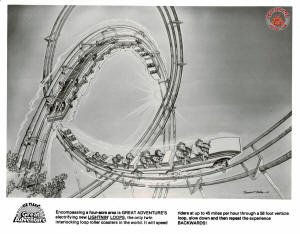 |
| |
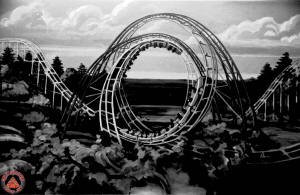 |
| |
|
|
When Six Flags acquired Great Adventure
in 1977 they saw great growth potential in the park. Serving one of the
world's largest markets meant they could go big. While the original
dream of Great Adventure was spectacular, a lack of practical experience
in building and operating a successful theme park impacted the plans for
growth.
Six Flags brought a wealth of experience to Great
Adventure and immediately began investing and improving the park. One of
the biggest opportunities they saw was the lack of major roller
coasters. In the mid-1970's looping roller coasters became a staple of
theme parks and Six Flags wanted to address this immediately and luckily
the park's previous owner already had the ball rolling. During the
1977 season, Great Adventure's owner signed a contract with Arrow for
the addition of the "Double Header Loop Ride" with construction underway
by October of that year. Renamed to "Lightnin' Loops" by Six
Flags, the ride would open during the 1978 season. Several parks had
installed Arrow Shuttle Loop coasters, but only as single units. Six
Flags Great Adventure was set to go bigger with two! |
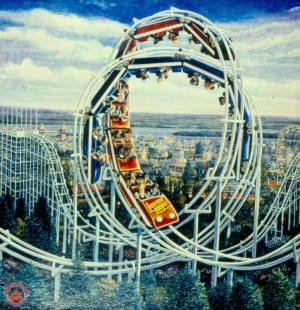 |
| |
|
|
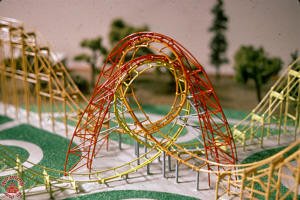 |
 |
| |
| For the 1978 season, Busch Gardens
The Old Country (now Busch Gardens Williamsburg) was adding the Arrow designed Loch Ness Monster coaster
which featured an interlocking loop design along a full circuit roller
coaster. Great Adventure got a similar visual impact with a lower
price tag and a much smaller footprint. Even so, while the Loch Ness Monster
had approximately two thousand extra feet of track, Lightnin' Loops
could do one thing Nessie couldn't - it traversed the loops both
forward and backwards. |
| |
 |
| |
|
|
 |
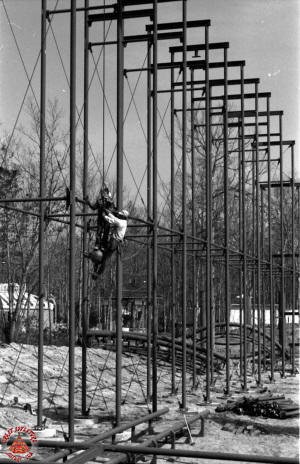 |
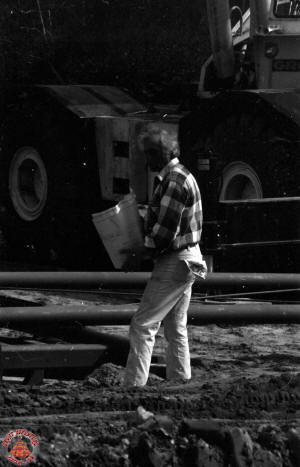 |
| |
|
|
 |
The plot of land selected for
Lightnin' Loops was a heavily wooded four acre site next to the Fun Fair
section of the park. Located not far from the Dream Street Skyride
station, placing the coaster here would allow for the theme park to have
two major roller coasters on opposite ends of Great Adventure.
The structure for Lightnin' Loops
involved two separate construction processes each building identical
rides at different heights. At the time roller coaster construction was
a much more complicated process. The lack of computer aided design and
the lack of precision manufacturing processes meant there was more
fitting of parts on site and adjustments made as needed.
The high
sets of station supports took shape first. These straight structural
frames were relatively simple and were very similar to the structures for
the park's two flume rides which were also
built by Arrow. |
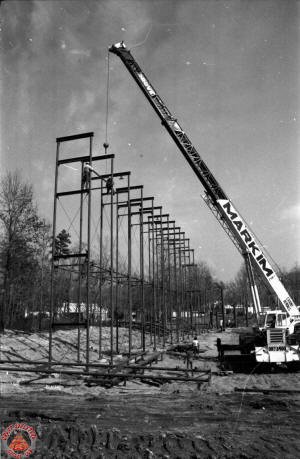 |
| |
|
|
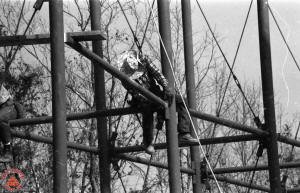 |
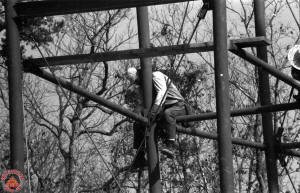 |
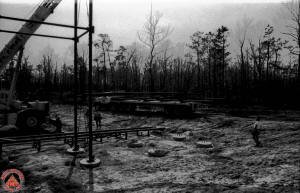 |
| |
|
|
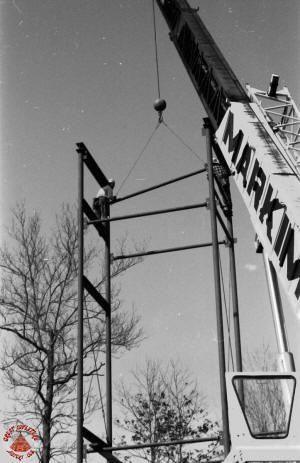 |
 |
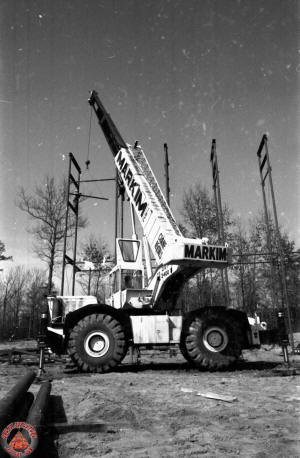 |
| |
|
|
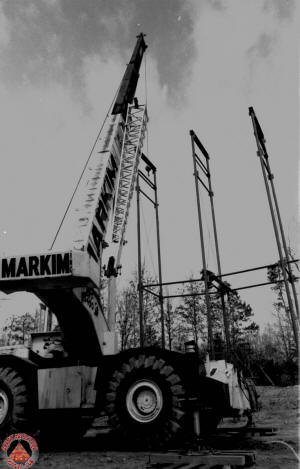 |
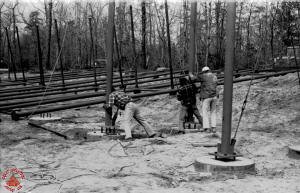 |
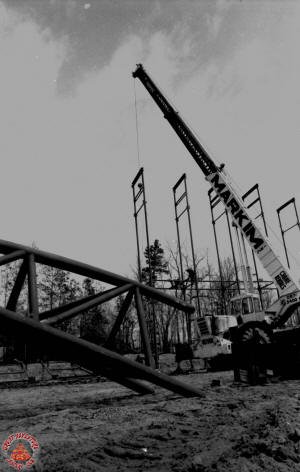 |
| |
 |
| |
|
|
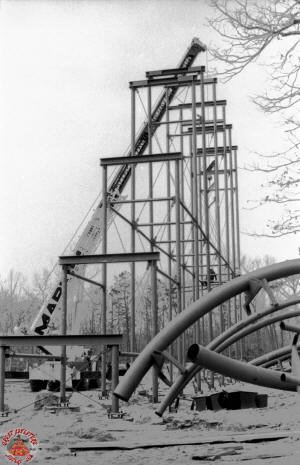 |
The upper most portion of the
structural supports would each accommodate a platform, four in all, that
had a series of graduated supports dropping down into a central pit
where the loops would be assembled. Track sections were then positioned
along these supports with the
lower loop's installation taking shape first while
supports for the upper loop stood all around it awaiting its turn to be
constructed.
It's interesting to note the track
sections were all designed to be welded together unlike today where new coasters
are often bolted allowing for easier relocation if needed. When
Lightnin' Loops was disassembled in late 1992 to make way for Batman The
Ride, these sections had to be cut apart instead of being simply
unbolted. |
 |
| |
|
|
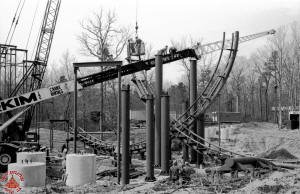 |
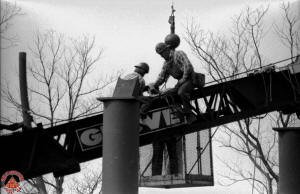 |
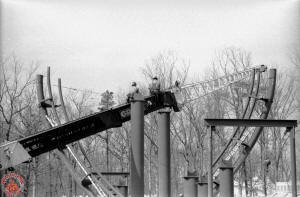 |
| |
|
|
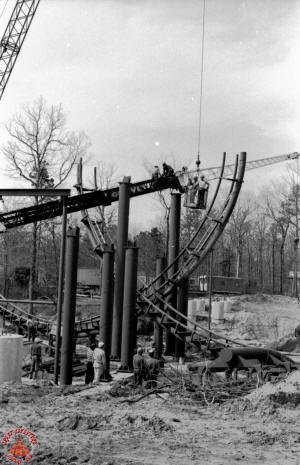 |
 |
 |
| |
|
|
 |
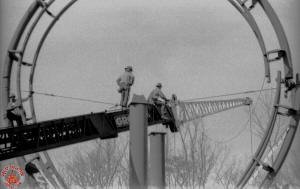 |
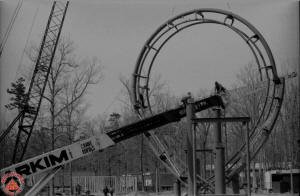 |
| |
|
|
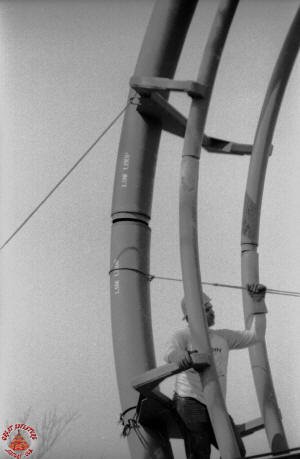 |
The track was delivered with only
a coat of reddish brown primer which the park would
paint after everything was assembled. Unlike bolted track, welding
joints often discolor requiring touch up so painting the entire ride on
site made sense.
As all the track arrived for both loops with the same primer color, each track section
was identified with stenciled letters marking each piece as either "LOW LOOP"
or "HIGH LOOP."
The loop tracks were
assembled without the support structure around the top of it. The loops
could stand on their own and would only require the extra supports
during operation of the trains. The supports would be added later
in the construction process.
|
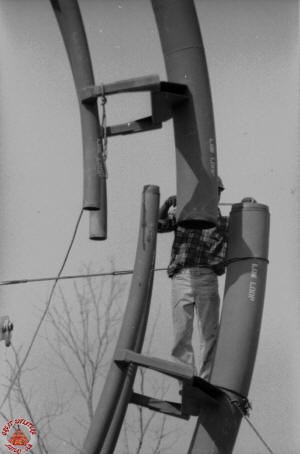 |
| |
|
|
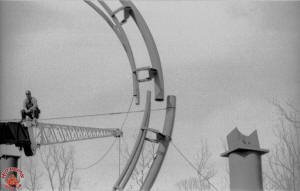 |
 |
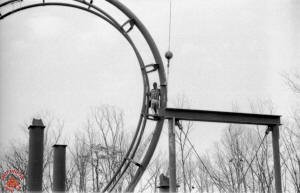 |
| |
|
|
 |
The lower loop's track was nearly
complete when they turned their attention to the upper loop. For
the workers, assembly followed the same process with the only
differences being this loop had taller supports and was higher off the
ground. |
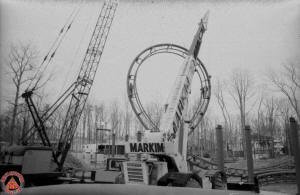 |
| |
|
|
 |
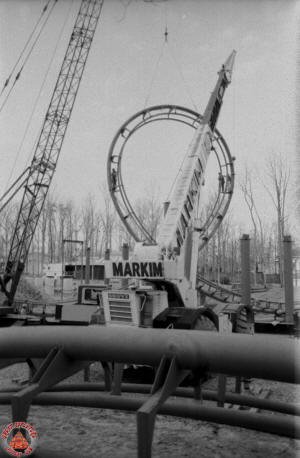 |
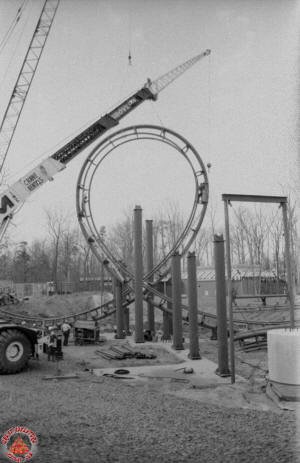 |
| |
|
|
 |
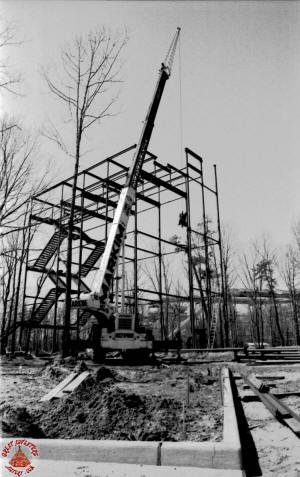 |
 |
| |
|
|
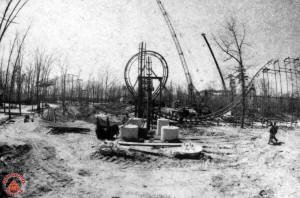 |
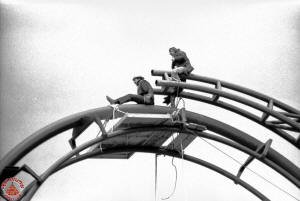 |
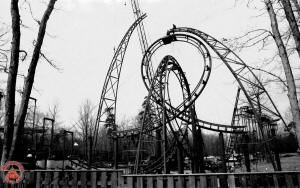 |
| |
|
|
 |
Meanwhile, the platforms for the
stations and staircases to them took shape. Once in place, tracks
on the platforms were adjoined to the tracks installed for the loops.
The last of the lattice supports were added to the upper loop and with
all the tracks and supports installed, the focus then switched to the
ride's launch mechanisms and electrical components.
|
 |
| |
|
|
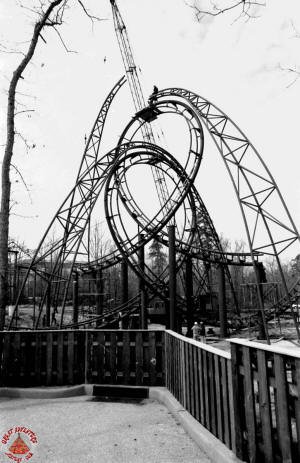 |
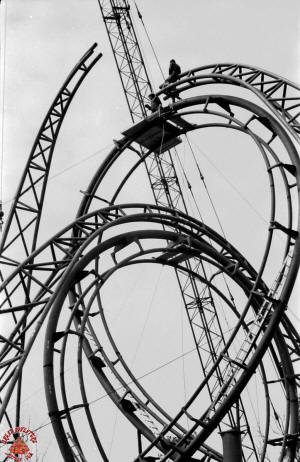 |
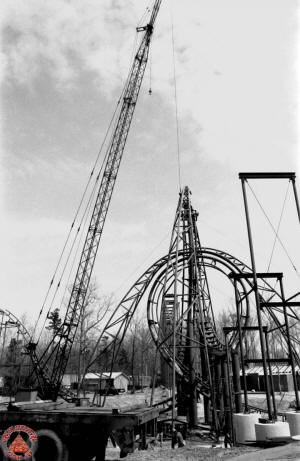 |
| |
|
|
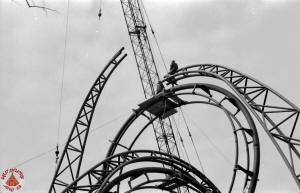 |
The interlocking
loops and their supports were very sculptural and made quite a visual
impact. The ride's original scale model featured a series of
meandering walkways which would have allowed guests to get up close to
the bases of the loops for even more impressive views of the ride.
This idea was shelved probably because of the ditch which needed to be
excavated for the lower loop. Instead, the ride's switchback queue
line was built near the loops to excite awaiting riders. |
 |
| |
 |
| |
|
|
 |
 |
 |
| |
|
|
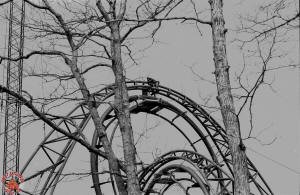 |
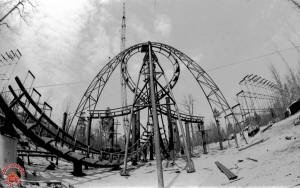 |
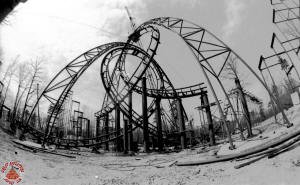 |
| |
|
|
 |
As the ride came together, the
crews worked to complete the coasters before the busy summer months.
The primary focus was on the lower loop
which opened May 23, 1978. The upper loop took longer, finally opening
July 18, 1978.
When complete, the whole structure glistened in shiny silver paint with blue
rails and stairs for the lower loop and red rails and stairs for the
upper loop. The ride would operate with a red train on the blue
track and a blue train on the red track. |
 |
| |
|
|
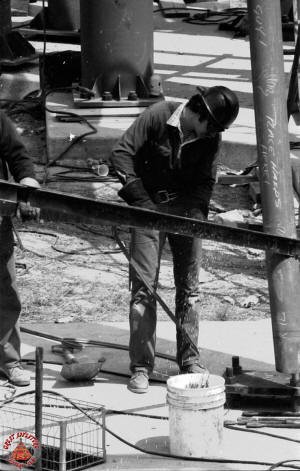 |
 |
 |
| |
|
|
 |
 |
| |
|
|
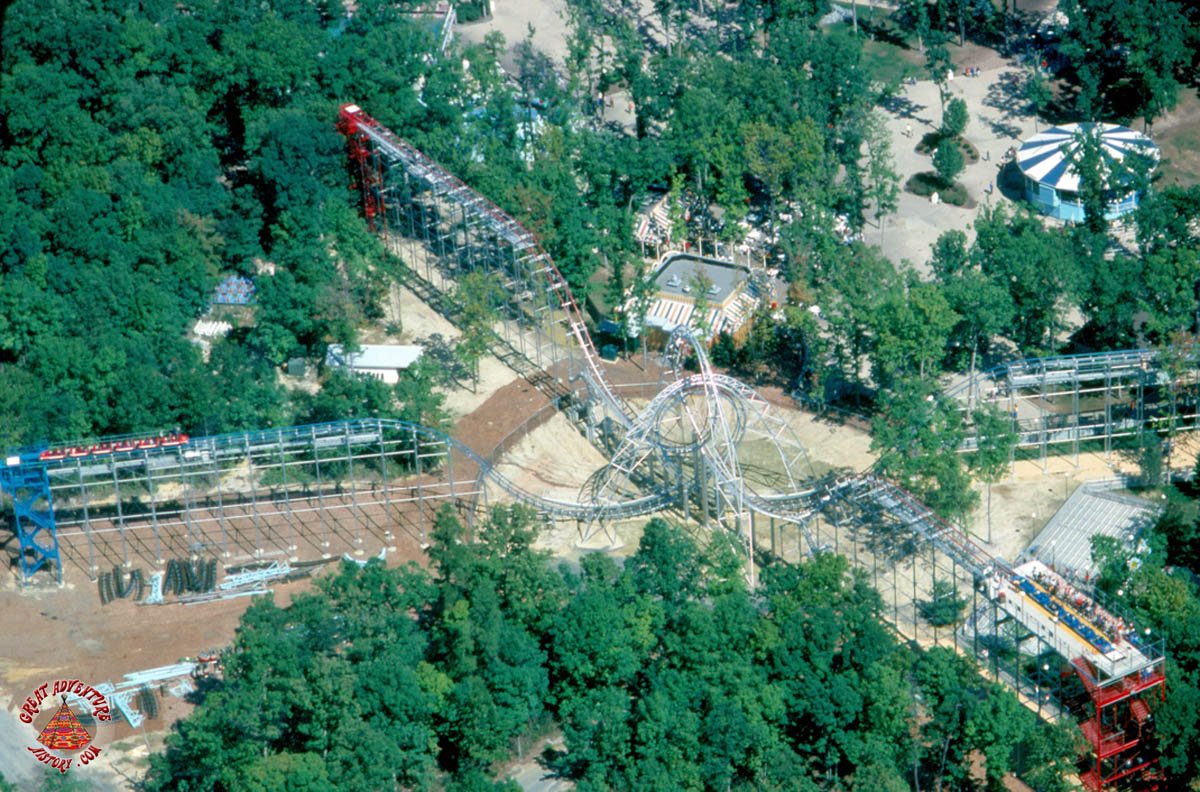 |
Six Flags Great Adventure's
Lightnin' Loops was a huge hit with crowds. Most people had never ridden
a roller coaster with an inversion, so for so many guests it was a real
milestone.
Given the anticipation of the loops, the excitement of the launch out of the station, and
then the prospect of doing it all backwards, Lightnin' Loops really was the height of
thrills at the time. |
| |
|
|
| Original
Spotlight: October 3, 2022; Updated: October 26, 2022. GAH Reference#: RIDE-1978-001C |
| |
|
|
 |
 |
 |

UPDATE COMING SOON! |
 |
 |
 |



